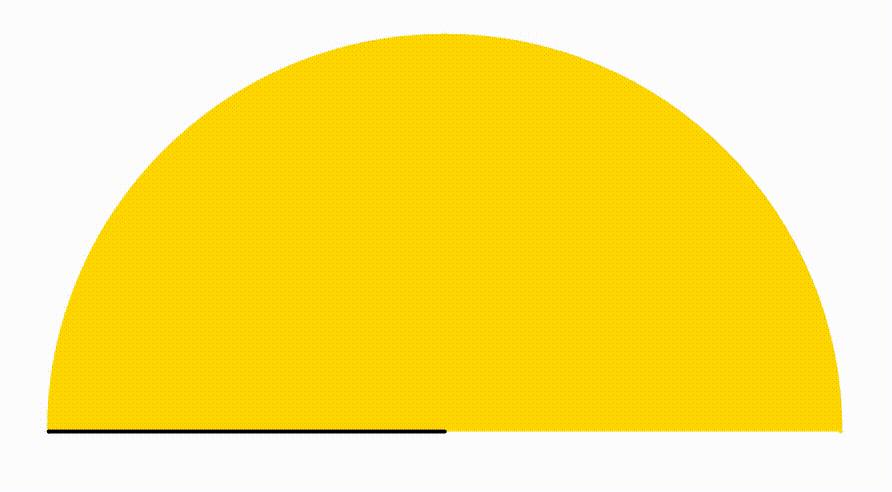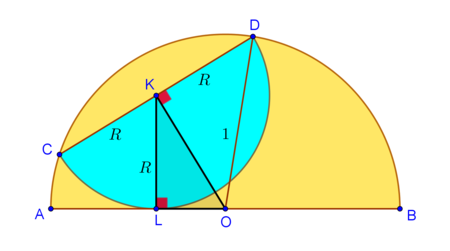Dynamic Geometry: P75
 The diagram shows a yellow semicircle. A cyan semicircle is moving freely inside the black semicircle so it is always internally tangent to it. We use the two centers and one tangency point to draw a black triangle. When the area of the triangle is
maximum
the ratio of the cyan area to the yellow
area
can be expressed as
q
p
, where
p
and
q
are coprime positive integers. Find
p
+
q
.
The diagram shows a yellow semicircle. A cyan semicircle is moving freely inside the black semicircle so it is always internally tangent to it. We use the two centers and one tangency point to draw a black triangle. When the area of the triangle is
maximum
the ratio of the cyan area to the yellow
area
can be expressed as
q
p
, where
p
and
q
are coprime positive integers. Find
p
+
q
.
The answer is 4.
This section requires Javascript.
You are seeing this because something didn't load right. We suggest you, (a) try
refreshing the page, (b) enabling javascript if it is disabled on your browser and,
finally, (c)
loading the
non-javascript version of this page
. We're sorry about the hassle.
2 solutions
Thank you for posting.
Label the diagram as follows, where O , K are the radii of the yellow and cyan semicircles respectively, L is the intersection of the cyan semicircle with the diameter of the yellow semicircle, A B and C D are the diameters of the two semicircles. For simplicity we set the radius of the yellow semicircle to be R = 1 .
 By Pythagorean theorem on
△
O
K
D
,
O
K
2
=
O
D
2
−
K
D
2
=
1
−
R
2
By Pythagorean theorem on
△
O
K
L
,
O
L
2
=
O
K
2
−
K
L
2
=
(
1
−
R
2
)
−
R
2
⇒
O
L
=
1
−
2
R
2
Hence,
[
O
K
L
]
=
2
1
K
L
⋅
O
L
=
2
1
R
⋅
1
−
2
R
2
Taking the derivative of
f
(
R
)
=
2
1
R
1
−
2
R
2
,
R
∈
(
0
,
2
1
]
,
f
′
(
R
)
=
2
1
(
1
−
2
R
2
+
R
2
1
−
2
R
2
−
2
R
)
=
2
1
1
−
2
R
2
1
−
4
R
2
Hence,
f
′
(
R
)
=
0
⇔
1
−
4
R
2
=
0
⇔
R
>
0
R
=
2
1
∈
(
0
,
2
1
]
This implies that the area of the black triangle gets maximised when
R
=
2
1
.
By Pythagorean theorem on
△
O
K
D
,
O
K
2
=
O
D
2
−
K
D
2
=
1
−
R
2
By Pythagorean theorem on
△
O
K
L
,
O
L
2
=
O
K
2
−
K
L
2
=
(
1
−
R
2
)
−
R
2
⇒
O
L
=
1
−
2
R
2
Hence,
[
O
K
L
]
=
2
1
K
L
⋅
O
L
=
2
1
R
⋅
1
−
2
R
2
Taking the derivative of
f
(
R
)
=
2
1
R
1
−
2
R
2
,
R
∈
(
0
,
2
1
]
,
f
′
(
R
)
=
2
1
(
1
−
2
R
2
+
R
2
1
−
2
R
2
−
2
R
)
=
2
1
1
−
2
R
2
1
−
4
R
2
Hence,
f
′
(
R
)
=
0
⇔
1
−
4
R
2
=
0
⇔
R
>
0
R
=
2
1
∈
(
0
,
2
1
]
This implies that the area of the black triangle gets maximised when
R
=
2
1
.
Then, Yelow area Cyan area = 2 1 π ( 1 ) 2 − 2 1 π ( 2 1 ) 2 2 1 π ( 2 1 ) 2 = 3 1 For the answer, p = 1 , q = 3 , thus, p + q = 4 .
Thank you Thanos !
Great solution. Much quicker way to get an expression for the triangle area than how I did it! To maximize the area, you could also bring the R into the square root and then complete the square in R 2 . [ O K L ] = 2 1 R 1 − 2 R 2 = 2 1 − 2 R 4 + R 2 = 2 1 − 2 ( R 4 − 2 1 R 2 + 1 6 1 ) + 8 1 = 2 1 8 1 − 2 ( R 2 − 4 1 ) 2 So the maximum area is 2 8 1 = 8 2 when R 2 = 4 1 .
Log in to reply
I'm glad that you liked it. Your shortcut bypasses calculus, so I go for it. I much prefer to use mathematical tools that are as simple as possible.
Let O and P be the centers of the yellow and cyan semicircles, their radii 1 and r , and diameters C D and A B respectively, and the triangle be O P N , where O P = a and O N = b . By intersection chords theorem ,
A P ⋅ P B r ⋅ r ⟹ r 2 = C P ⋅ P D = ( 1 − a ) ( 1 + a ) = 1 − a 2
By Pythagorean theorem ,
O N 2 + P N 2 b 2 + r 2 b 2 ⟹ b = O P 2 = a 2 = 1 − r 2 = 1 − 2 r 2 = 1 − 2 r 2
The area of △ O P N is given by:
A d r d A ⟹ r = 2 1 b r = 2 r 1 − 2 r 2 = 2 1 − 2 r 2 1 − 4 r 2 = 2 1 To find maximum A Putting d r d A = 0
This means that A is maximum when r = 2 1 , then
A y e l l o w A c y a n = π − 4 π 4 π = 3 1
Therefore p + q = 1 + 3 = 4 .